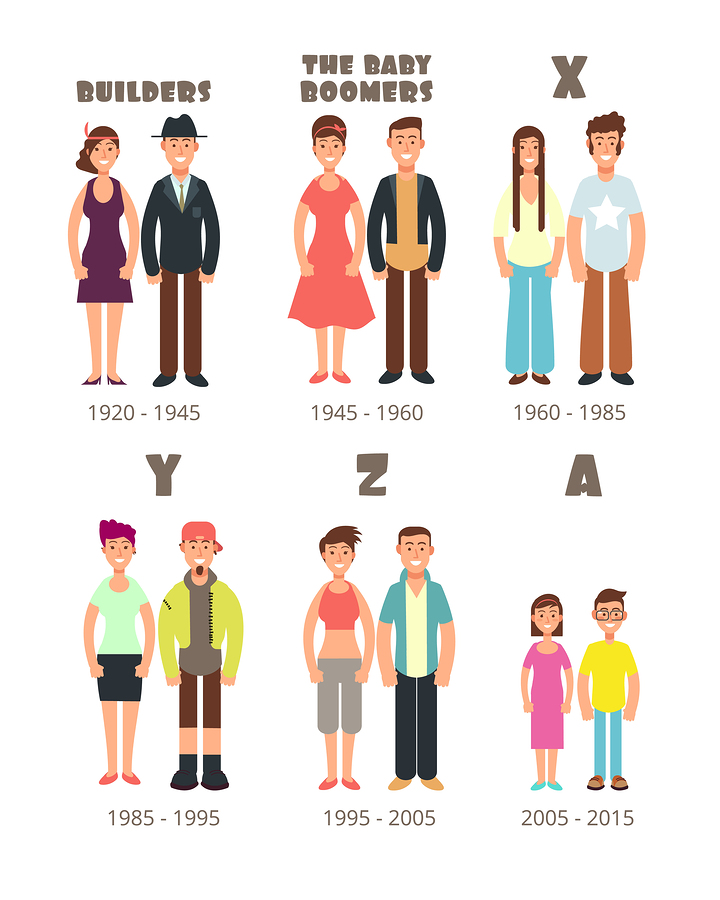Gen Zs are entering the workforce. Are you prepared for this newest generation?
Is Gen Z Real?
We’ve all heard of millennials. But who is Gen Z? Well, Gen Z is the generation right after millennials. And, it may surprise you to know they have started entering the workforce. Data suggests that by 2020 this generation will outnumber the millennials. They will make up 40% of the working and consumer population.
Gen Z vs. millennials
 Just when we were becoming comfortable with millennials; now we need to learn what makes this new generation tick. Gen Z has a lot in common with the generation before them, but there are a lot of differences too. To simply lump them in with millennials would be a mistake. Generations are defined by birth years (not current age) and the events that impacted them as they were growing up. For example, millennials were raised during an economic boom and Gen Zs were raised during a recession. Gen Zs have never known a world without technology; while millennials have seen significant growth in technology adoptions. Millennials are seen as more optimistic and Gen Zs are viewed as more pragmatic. So, how can DISC help us prepare for these new up and comers?
Just when we were becoming comfortable with millennials; now we need to learn what makes this new generation tick. Gen Z has a lot in common with the generation before them, but there are a lot of differences too. To simply lump them in with millennials would be a mistake. Generations are defined by birth years (not current age) and the events that impacted them as they were growing up. For example, millennials were raised during an economic boom and Gen Zs were raised during a recession. Gen Zs have never known a world without technology; while millennials have seen significant growth in technology adoptions. Millennials are seen as more optimistic and Gen Zs are viewed as more pragmatic. So, how can DISC help us prepare for these new up and comers?
How DISC can help
We are complex human beings. Sure, generations share things in common; after all, isn’t that why generations exist? However, we don’t want to label or pigeon hole people. At Extended DISC, we believe all people have similarities and differences. We can no longer think of simply treating people the way we want to be treated; because, let’s face it; not everyone is like us. Instead, we recommend discovering what motivates and drives each person individually so you can interact with them the way THEY prefer. Now, don’t get me wrong. I’m not saying we need to become like Gen Z. What I’m saying is we need to find out what drives and motivates Gen Z and make brief, temporary adjustments to interact more successfully with them. So how do we find out what drives and motivates Gen Z, and people in general? Well, we do it in 4 easy steps.
Step 1
 At Extended DISC we follow 4 steps to effective behavior modification. These 4 steps can be applied across all generations. Step 1 is understanding how people are similar and different. We use the 4 Quadrant DISC Model to help us understand those differences and similarities. Let’s take a look. D-style individuals like to be “large and in charge”. They are task-focused and are often seen as assertive and decisive. They frequently use pronouns such as “me” and “I” because they tend to be more individualistic than the other styles. Their biggest fear is loss of control. I-style individuals are the social butterflies of the styles. They like to be around people. There are no strangers to an I-style; just opportunities to make new best friends. They are talkative, enthusiastic, and persuasive. Oftentimes, the glass is overflowing with I-styles because of their optimism. I-styles biggest fear is not being liked. S-styles are the ‘Steady Eddies’ of the group. They prefer things to stay the same. Oftentimes, they are seen as patient, calm, amiable, and trustworthy. They are active listeners and put a lot of emphasis on relationships. S-styles use pronouns such as “we” and “us” because it’s all about others. S-styles fear loss of stability. C-styles are the most formal of the styles. They are rule followers with lots of structure and discipline. These individuals are driven by quality and precision. They like and want to be right. If a topic interests them, they are attentive listeners. C-styles do not enjoy chitchat and tend to ask a ton of questions. They are constantly digging for more data and proof. They fear criticism of their work.
At Extended DISC we follow 4 steps to effective behavior modification. These 4 steps can be applied across all generations. Step 1 is understanding how people are similar and different. We use the 4 Quadrant DISC Model to help us understand those differences and similarities. Let’s take a look. D-style individuals like to be “large and in charge”. They are task-focused and are often seen as assertive and decisive. They frequently use pronouns such as “me” and “I” because they tend to be more individualistic than the other styles. Their biggest fear is loss of control. I-style individuals are the social butterflies of the styles. They like to be around people. There are no strangers to an I-style; just opportunities to make new best friends. They are talkative, enthusiastic, and persuasive. Oftentimes, the glass is overflowing with I-styles because of their optimism. I-styles biggest fear is not being liked. S-styles are the ‘Steady Eddies’ of the group. They prefer things to stay the same. Oftentimes, they are seen as patient, calm, amiable, and trustworthy. They are active listeners and put a lot of emphasis on relationships. S-styles use pronouns such as “we” and “us” because it’s all about others. S-styles fear loss of stability. C-styles are the most formal of the styles. They are rule followers with lots of structure and discipline. These individuals are driven by quality and precision. They like and want to be right. If a topic interests them, they are attentive listeners. C-styles do not enjoy chitchat and tend to ask a ton of questions. They are constantly digging for more data and proof. They fear criticism of their work.
Step 2
Now that we understand how people are similar and different, it’s time to learn more about yourself individually. How do you show up? What drives and motivates you? What demotivates you? How do you respond under pressure? The Extended DISC® Assessments give you these details in a user-friendly format that provides you with self-awareness and practical application. Heck, you might even find out you have something in common with your Gen Z co-workers.  Step 3 is part art, part science, and mostly practice. Step 3 is identifying the DISC style of others. It’s learning what makes an individual tick through the lens of the Four Quadrant DISC model. At Extended DISC, we use OAR, a three-step process for identifying the main DISC Style of others. OAR is an acronym that stands for Observe, Assess, and Recognize. We observe the person’s patterns of behavior. Next, we assess if the person is more task-oriented or people-oriented, and if they are more active or reserved. Lastly, we recognize their dominant DISC style. In this step we have the opportunity to apply our knowledge from Step 1. Remember, we’re not trying to pigeon hole anyone or label them. We want to identify their main DISC style so we’ll know how best to move into Step 4.
Step 3 is part art, part science, and mostly practice. Step 3 is identifying the DISC style of others. It’s learning what makes an individual tick through the lens of the Four Quadrant DISC model. At Extended DISC, we use OAR, a three-step process for identifying the main DISC Style of others. OAR is an acronym that stands for Observe, Assess, and Recognize. We observe the person’s patterns of behavior. Next, we assess if the person is more task-oriented or people-oriented, and if they are more active or reserved. Lastly, we recognize their dominant DISC style. In this step we have the opportunity to apply our knowledge from Step 1. Remember, we’re not trying to pigeon hole anyone or label them. We want to identify their main DISC style so we’ll know how best to move into Step 4.
Step 4
Step 4 is modifying your style to improve interactions with others. These modifications are often brief and temporary; it may be as simple as slowing down your presentation and providing more details. Or, it may mean being brief and not providing every single detail. Your Extended DISC® Assessment provides specific tips based on your DISC style.
What does the research say?
So, what does the research say? Well, at Extended DISC it’s important to us that we validate our tool. We want to ensure we have a credible and reliable tool. We have been conducting studies since 1994 and all our studies support that the global population continues changing its most preferred DISC style. According to the 2017 Extended DISC FinxS Validation report the trends we see in age studies support that millennials trend to I-style and Gen Zs appear to be trending to C-style. It’s still early to tell about the new generation as we are still collecting data as they emerge into the workplace. Remember, we don’t want to label or pigeon hole anyone. These are simply trends we’ve noticed in the data.
Bottom Line
 We all have preferred ways of doing things. Don’t let generational differences frighten you. Following the Extended DISC 4 steps to effective behavioral modification will provide you with a roadmap. It supplies tips on how best to modify your behaviors to improve interactions with other styles. It gives you a common language that can be used across all generations. It can also give us commonalities that birth years and events don’t. Using the language of DISC and applying the 4-step process will help us all stay “on fleek”. In other generational words, “on point” or “perfectly executed”. So, next time you’re working with a Gen Z, don’t be frustrated by how they are different from you. Embrace who they are and what they bring to the table. Find their strengths. Model the application of DISC and you might find out you have more in common with these new up and comers than you realized.
We all have preferred ways of doing things. Don’t let generational differences frighten you. Following the Extended DISC 4 steps to effective behavioral modification will provide you with a roadmap. It supplies tips on how best to modify your behaviors to improve interactions with other styles. It gives you a common language that can be used across all generations. It can also give us commonalities that birth years and events don’t. Using the language of DISC and applying the 4-step process will help us all stay “on fleek”. In other generational words, “on point” or “perfectly executed”. So, next time you’re working with a Gen Z, don’t be frustrated by how they are different from you. Embrace who they are and what they bring to the table. Find their strengths. Model the application of DISC and you might find out you have more in common with these new up and comers than you realized.
